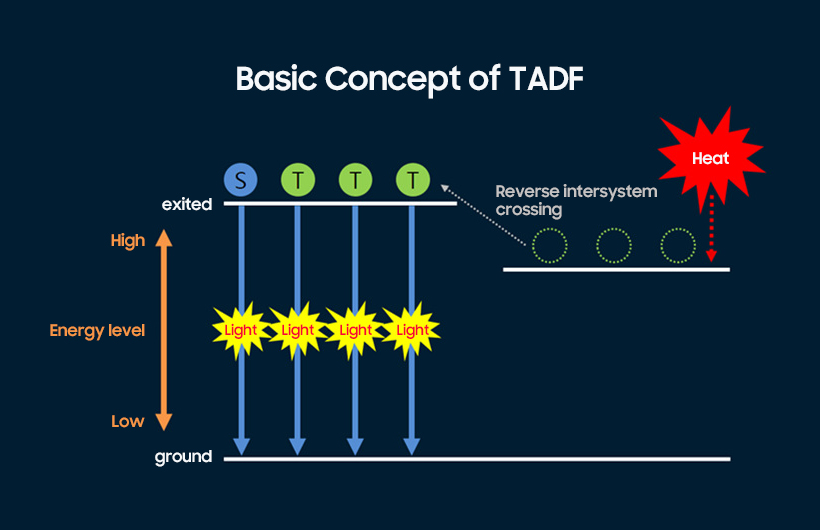
Thermally activated delayed fluorescence (TADF) is one of the OLED luminescence methods currently being researched.
Fluorescence, the primary form of luminescence for OLED displays, has a high level of stability when used in a light-emitting material but has low luminous efficacy (25% in terms of internal quantum efficiency). In contrast, phosphorescence can offer up to 100% of internal quantum efficiency but has only been used for red and green light among the primary colors of RGB so far. It also increases the cost of production as it uses rare metals in the platinum group (rare-earth elements). TADF is garnering much attention as a promising alternative thanks to its advantage of driving the internal quantum efficiency to 100% without using the rare platinum-group metals.

Thermally activated delayed fluorescence (TADF) maximizes luminous efficacy by adding a special element to how fluorescence works. First, to induce fluorescence, energy is injected into the organic light-emitting diode to increase the level of energy of the electrons inside the material (into an ‘excited’ state) so that, when the energy level of the electrons is lowered (into a ‘ground’ state), the energy is released in the form of light. Think of a meteor radiating light as it plummets towards the Earth as an analogy of how TADF works.
When energy is injected into the light-emitting diode in order to excite the electrons, four light-emitting particles are created as seen in the illustration above. These are called ‘excitons.’ One of the four excitons is a particle that can emit light through fluorescence (singlet exciton), while the other three are unable to emit light and are released either as heat or vibration (triplet excitons). In other words, fluorescence only uses one exciton out of four for light emission - only 25% of the particles are used to emit light.

This is where thermally activated delayed fluorescence (TADF) comes in. TADF moves the three triplet excitons (T) that are lost in fluorescence to a singlet exciton level (S) to induce fluorescence. Dubbed a reverse intersystem crossing (RISC), TADF induces the reverse movement of excitons by using heat. Through this process, all four excitons can emit light. In order to facilitate the mobility of excitons, TADF uses an organic light-emitting material that creates a small energy gap (ΔEST), improving the internal quantum efficiency to 100%.
TADF is drawing much attention as an innovative method for luminescence with reduced costs for materials and high luminous efficacy. However, it is still in the research and development phase to be commercialized as the next-generation technique due to the lack of stability in the light-emitting materials in an excited state.



